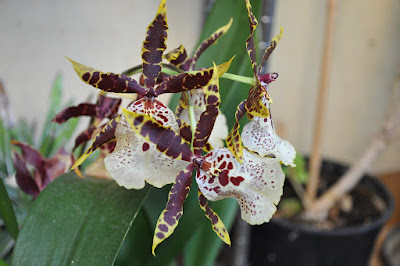Degarmoara orchid is the nothogenus comprising intergeneric hybrids between the orchid genera Brassia, Miltonia and Odontoglossum. Flower color is usually white, brown, orange with with speckles.
Degarmoara orchid is the nothogenus comprising intergeneric hybrids between the orchid genera Brassia, Miltonia and Odontoglossum.
IDENTIFY DEGARMOARA ORCHID PLANT
Degarmoara orchid is considered to part of the Oncidium alliance and has similar cultural requirements. They require conditions similar to Colmanaras and are regarded as one of the easiest members of the Oncidium alliance to grow.
The orchid from this genus can flower twice a year in autumn and spring if growing well. The flowers are large and long lasting and can have a pleasant fragrance. Flower color is usually white, brown, orange with with speckles.
DEGARMOARA ORCHID PLANT CARE AND CULTURE
Cultural information should only be used as a guide, and should be to be adapted to suit you. Your physical location; where you grow your plants, how much time you have to devote to their care, and many other factors, will need to be taken into account. Only then can you decide on the cultural methods that best suit you and your plants.
Light:
Degarmoara orchid prefer low light and about 50-70% shade cloth or 15000-30000 lux is ideal in summer.
Temperature:
The plant of this genus are more tolerant of higher temperatures than Odontoglossums due to the Brassia in the parentage. They will tolerate temperatures of 40°C in summer and as low as 1°C in winter however they prefer temperatures in the range of 10 to 27°C for optimum growth. They will not tolerate frosts. A drop in temperature is required to promote flowering.
Humidity:
Degarmoara orchid prefer a humid environment with 55-75% humidity. Too dry air has a negative effect on the development of the plant: its growth is inhibited, and the leaves begin to turn yellow and dry out. The higher temperature, the higher the humidity should be, and the higher the humidity, the more often and longer it is necessary to ventilate the room where the plants are contained, otherwise the probability of rotting and various kinds of fungal diseases.
Substrate, growing media and repotting:
These orchids can be grown mounted on wood, bark or tree-fern slabs or gown in pots or wooden baskets. Mounted plants allow quicker drying after watering. Keep pots as small as possible. Ensure you have at least 3 bulbs and a new shoot to a division when subdividing. Potting medium varies with your watering regime and plant size. As they have finer roots they do best with a smaller grade (9-12mm) bark/perlite 50:50 mix or 3 parts bark to 1 perlite.
Plants in pots should be repotted about every two years in spring after flowering. Plants should be repotted as soon as they have commenced active growth in spring and shoots are 5-7cm tall. Ensure base of new growth is planted about 1.5cm deep into bark but no deeper. They prefer squat shaped pots and do not over pot, use a pot only slightly larger than the old one.
Watering:
They prefer frequent and abundant watering in warmer months. Plants grown mounting may need to be watered daily in summer. Avoid watering late in the day so leaves are dry by evening. They like a drier rest during cooler winter months. Just apply the occasional water in winter or mist to prevent pseudobulbs shriveling. Regular watering should recommence in about September when new growths start. If plants are kept too wet they will lose their roots.
Watering is directly dependent on the temperature of the content, the higher it is, the more often it needs to be watered. When watering, excess water should flow freely from the pot, since stagnation of water both inside the pot and in its pan can very quickly lead to rotting of the roots and the lower part of the plant.
Overwatering in winter and poor drainage are primary causes of plant loss. If plants have wrinkled leaves they may not be getting enough water and may need repotting. Similarly if pseudobulbs start to shrivel this is a sign plants need more water. Overwatering particularly in cool weather and poor drainage are a common cause of poor plant growth and these should be investigated if plants are not performing well.
Fertilizer:
Degarmoara orchid require frequent application of quarter to half strength fertilizer during their growing season. Root tips can die and roots turn brown if the fertilizer is too concentrated. A teaspoon of gypsum and half a teaspoon of Dolomite sprinkled on the top of the pot will add calcium, magnesium and counter excess acidity.
Rest period:
This species need less water in the winter, especially if they grow under the conditions of a dark, short day that occurs at moderate latitudes. They should dry somewhat between waterings, but they should not be dry for a longer period. Frequent morning fogging and rare, economical watering should allow the plant to go through a dry period of rest, while providing it with sufficient humidity. Fertilization should be reduced or eliminated until new growths appear and a more abundant spring watering begins.















COMMENTS